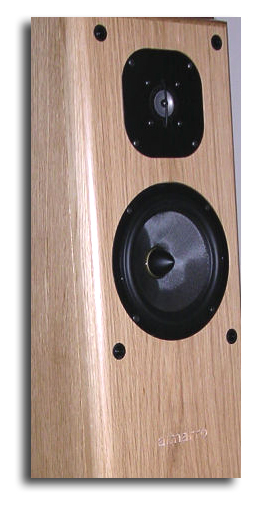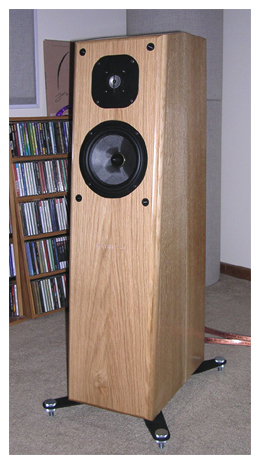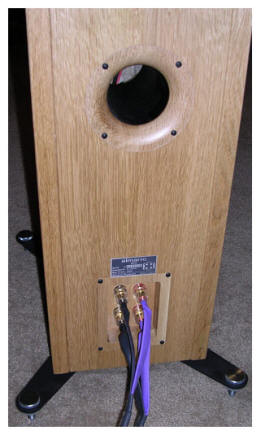
You are reading the older HTML site
Positive Feedback
ISSUE
22
almarro
M2A loudspeakers
as reviewed by John Acton

|
JOHN ACTON'S SYSTEM
LOUDSPEAKERS
ELECTRONICS
SOURCES
CABLES
ACCESSORIES
|
On my way to visit another exhibitor at the HE2005 show in New York, I almost passed up Almarro's room. I'm glad I didn't. They had the most musical system I heard at the show, and the biggest surprise was the relatively low cost of their products. I was instantly smitten, so much so that I couldn't stay away.
Almarro is based in Japan, and is a subsidiary of the Network Supply Corporation, a company primarily focused on the manufacturing of high-tech communication devices. Specializing in loudspeakers and integrated tube amps, Almarro is owned and operated by Yoshihiro Muramatsu, with assistance from his sons Takashi and Hiroyasu. With connections garnered from the parent company's quarter-century of experience in the electronics industry, Almarro has been able to partner with suppliers of custom transformers, electronic parts, and loudspeaker drivers. Muramatsu learned woodworking from his father, and has a hand in all of the wood cabinets featured in Almarro loudspeakers (and several of their amplifiers).
The speakers in the system that so impressed me at HE2005 were the M2A floorstanders, so it made the most sense for me to review those. The speakers were shipped in two large, heavy cardboard containers. The boxes were two-ply wraparound affairs. There was plenty of bubble wrap and air-filled plastic stuffing, but one speaker had a mark on the top left side, possibly due to its 80-pound weight. Almarro should look into more substantial packaging.
 The M2As are incredibly well constructed.
The heavy, inert cabinets of the review pair were made of thick sheets
of solid oak sourced from Hokkaido, the northern island of Japan. Their
finish is very attractive. The retail price of the review pair is $2900,
but several cabinet options are available, from MDF at $2300 per pair,
to pine at $2700, to piano black at $3000. According to Muramatsu, the
type of wood affects the sound quality. Pine is said to resonate the
most, with oak the least resonant and MDF falling between. Almarro is
working on ways to raise the performance level of the MDF and pine
cabinets to that of oak.
The M2As are incredibly well constructed.
The heavy, inert cabinets of the review pair were made of thick sheets
of solid oak sourced from Hokkaido, the northern island of Japan. Their
finish is very attractive. The retail price of the review pair is $2900,
but several cabinet options are available, from MDF at $2300 per pair,
to pine at $2700, to piano black at $3000. According to Muramatsu, the
type of wood affects the sound quality. Pine is said to resonate the
most, with oak the least resonant and MDF falling between. Almarro is
working on ways to raise the performance level of the MDF and pine
cabinets to that of oak.
According to the specs, each M2A is 40 inches high, 9.5 inches wide, and 16 inches deep at its base, but I measured a height of 35.5 inches. This places the tweeters 31 inches from the floor, considerably below the ear level of a typical seated listener. However, the front baffle slopes gently back, which helps align the drivers with the listener's ears, and provides a certain amount of time alignment for the drivers. Outrigger feet can be installed at each of the speaker's bottom corners to decouple the cabinet and raise it another two inches or so off the floor. Substantial cone/spike assemblies that thread into metal inserts on the bottom of the speaker allow for leveling and height adjustments.
The driver complement consists of a 1-inch Focal inverted-dome titanium tweeter and a 6-inch NEO grass-fiber honeycomb woofer with an integral phase plug. The M2A, a conventional two-way design, is a departure from previous Almarro speaker designs, which featured full-range drivers. On the rear panel of the M2A is a pair of high-quality, biwire-capable binding posts and a flared bass reflex port. Almarro provides 5-inch jumpers, equipped with banana plugs, for single-wiring. I was also provided with the optional accessories, which include acoustical foam for stuffing the ports and silicon-enhanced outrigger bases for augmented resonance control in the bass. The user manual is fairly thorough, and provides information about hookup and positioning of the speakers, and installation of the outrigger feet and optional silicon bases.
Despite their relatively compact size, the M2As are capable of nearly full-range performance, and are rated to 29Hz (-3 dB). Placement in my smallish room proved to be more troublesome than usual. After some experimentation, I settled on a near-field configuration, with the speakers far away from the rear wall, far apart, and slightly toed in toward the listening position. With this positioning, I was able to get an incredibly wide soundstage with exceptional center fill and deep, controlled bass. I experimented with the outrigger feet and the optional silicon bases, and got greater coherency, transparency, and bass tautness with the silicon bases than with the speakers placed directly on the floor or on the outrigger feet alone. I also experimented with speaker cabling, and much preferred the Audience Au24 cables single-wired to a set of bi-wired Analysis Plus Oval 9s, which sounded too thick, warm, and closed in. The Au24s had greater clarity, openness, transparency, and imaging precision. Replacing the stock Almarro jumpers with Audience Au24 jumpers brought further improvements. The M2As performed well with solid-state amplification, but only came into their own when mated with tube amplifiers. They gained light and bloom in the midrange, and more clarity and air in the treble. Break-in was not an issue with my review pair, but Muramatsu recommends between 100 and 200 hours for new speakers.
If I were to choose one word to sum up the sound of the Almarro M2A loudspeakers, it would be 'smooth.' Smooth did not mean uninvolving. The M2As seduced me instead of forcing themselves upon me. There were no peaky or strident colorations. The sonic palette was warm and full-bodied, with a mellow-sounding treble that was extended but slightly reduced in level. In spite of the reticent top end, the Focal tweeters sounded quick, clean, and extended, and after I became acclimated to the polite balance, I found that the M2As were quite resolving, though relaxed.
 U2's back catalog is in dire need of remastering. Their second release,
October (Island 422-842 297-2), is
dynamically flat and tonally lifeless. The CD manages to sound both edgy
and shut-in, but played on the M2As, the edginess was greatly reduced,
and Bono's vocals were clearer, with greater substance and less digital
glare. While the pervading murkiness of the recording remained, I found
myself listening past the CD's flaws to the beauty of songs like "I Fall
Down' and "Tomorrow." Harder-rocking numbers like "I Threw a Brick
Through a Window" were also well served by the M2As, with the reduced
grit and edge highlighting the angry guitar and drum work and Bono's
pugilistic vocals.
U2's back catalog is in dire need of remastering. Their second release,
October (Island 422-842 297-2), is
dynamically flat and tonally lifeless. The CD manages to sound both edgy
and shut-in, but played on the M2As, the edginess was greatly reduced,
and Bono's vocals were clearer, with greater substance and less digital
glare. While the pervading murkiness of the recording remained, I found
myself listening past the CD's flaws to the beauty of songs like "I Fall
Down' and "Tomorrow." Harder-rocking numbers like "I Threw a Brick
Through a Window" were also well served by the M2As, with the reduced
grit and edge highlighting the angry guitar and drum work and Bono's
pugilistic vocals.
Voices in general were outstanding. I was entranced by the purity and natural tone of Bjork's singing on Vespertine (Elektra 62653-2). On "Unison," her voice soared above and between the speakers, with a superb mix of natural body and light. Her ethereal voice was as equally convincing on "Heirloom," and the trip-hop beats on this track showed off the dynamic abilities of the M2As.
Having grown accustomed to mini-monitors, it was truly revelatory to experience the bass extension and power of the M2As. The subterranean sequences on songs like "Arc-Angel" and the title track of Arc's Radio Sputnik (DiN 7) rumbled through my room with a solidity I had not previously experienced. There was no artificial thickening or bloating of bass textures, and the M2As revealed their bass capabilities only when the recording possessed deep bass.
Soundstaging was likewise excellent. I routinely heard sounds emanating from beyond the confines of the speaker cabinets. Despite their diminutive size, the soundstage height of the M1As was similarly exemplary. Images floated above and beyond the speakers, and when the recording called for it, the entire back wall came to life. Depth was very good, but because of the slightly soft and mellow tonal balance, the soundstage was a tad recessed.
Unlike many Pink Floyd fans, my favorite Floyd album is The Final Cut (Columbia CK 68517). For all intents and purposes a Roger Waters solo album, this recording is musically and sonically superb, and really showcased the M2As' soundstaging abilities. "Your Possible Pasts" was impressive, juxtaposing Waters' rich vocals with thundering dynamics as the band revved up for the chorus and guitar solos. "Paranoid Eyes" may be the finest-sounding track. The mewling cat at the beginning of the song seemed to emanate from the other side of the wall behind the right speaker. Waters' plaintive vocal had a palpable presence in the room. Playing this CD was a transcendental experience. The room melted away, and I felt directly plugged into the performance. I could not identify the speakers as producers of sound.
Bill Frisell is a brilliant and eclectic jazz guitarist who often incorporates elements of folk, blues, and even bluegrass stylings into his playing. His album with Dave Holland and Elvin Jones, simply titled Bill Frisell with Dave Holland and Elvin Jones (Nonesuch 79624-2), is a sonic tour de force, and it sounded wonderful over the M2As. On "Coffaro's Theme," the contrast between Frisell's acoustic playing and the underlying guitar tape loops is underpinned by Holland's superb bass playing. It was easy to follow the disparate musical elements, even when Frisell's electric guitar is added toward the end of the song. Nevertheless, the recording emphasized the M2As' sonic reticence. Their signature smoothness and subtly recessed top end slightly dampened the dynamics of Elvin Jones' drum solo at the opening of 'Again.' His cymbal work was robbed of the slightest bit of shimmer and presence.
Peter Gabriel's remastered fourth CD, officially untitled but unofficially known as Security (Geffen 069 493 266-2), highlighted the best aspects of the M2As' sonic personality. I have never heard the first track, "The Rhythm of the Heat," sound better. The drums exploded out of the space between and behind the speakers. Gabriel's voice hung suspended in space, with a warm, natural tonality. The M2As brought out the poignancy in Gabriel's singing on "Wallflower," and succeeded in connecting me to the heart of the performance. Although I was extraordinarily happy listening to this CD on the Almarros, they diminished some of the delicate percussion in songs like "Lay Your Hands On Me" and "Kiss of Life."
When I compared my ProAc Tablette Reference 8 Signatures to the much larger Almarro M2As, significant differences were apparent, despite the fact that both speakers were clearly voiced to be musical rather than analytical. The Tablettes had better focus and precision than the M2As, and rendered sharper contrasts between performers within the soundstage. Though the M2As were more diffuse, with softer outlines, they conjured up a more realistically sized soundstage, with larger, more present images. Both speakers sounded warm and full in the midrange, giving voices and other midrange instruments a burnished glow. The Almarros continued had this glow down into the bass, where they markedly surpassed the ProAcs in extension and power. The Almarros offered a musical foundation altogether absent with the diminutive ProAcs, and greater insight into the dimensions of the soundstage. The ProAcs sounded quicker, their smaller drivers and cabinets able to respond better to subtle microdynamic shadings. Conversely, the Almarros had the upper hand in their portrayal of macrodynamics, allowing me to play bass-heavy music louder, with less congestion.
Despite these differences, the two speakers were quite similar. Both are musical communicators, and both can create that tenuous emotional connection between the listener and the music. The two speakers diverge the most in their top end performance. Both sound airy and extended, but the ProAcs have a distinctly stronger treble than the more polite Almarros. The M2As are softer and mellower, with less focus on sibilants. On bright sounding recordings, this was actually preferable, as it allowed me to focus more on the musical message, but on softer sounding recordings, I sometimes wished for just a little more vividness to the top end.
Because of their polite, non-aggressive treble, detail aficionados may not find them to be their cup of tea. The M2As are capable of genuine deep bass, and while this is not a drawback, it does warrant care in placement. These speakers require some room to breathe. Almarro recommends at least 20 inches between the rear of the M2As and the wall behind. I would recommend more. Even then, listeners with small rooms may have to do a lot of experimenting with placement. Lastly, the M2As have a definite preference for tubes. This, too, is hardly a drawback, but seems to be a deliberate choice made by the designer.
Almarro is making quite a name for itself with its tube amplifiers and speakers. The beautifully finished M2A loudspeakers deserve to be added to their list of lauded products. Not the last word in resolution, the M2As instead provide a warm and musical sound that rewards the listener with a relaxed and immersive experience. Properly set up, the M2As are terrific performers that acquit themselves well with all types of music. Their spacious soundstaging and realistic dynamics ably serve pop, rock, and other bombastic fare, while their warm and liquid midrange highlights voices and acoustic instruments. At their price, the Almarro M2As perform better than the norm. John Acton
-
Drivers: Tweeter: 1" Focal TC 120 Tdx, Woofer: 6.5" Honeycomb cone
-
Crossover: 1st order 2way with crossover at 3000Hz
-
Power handling: 85W
-
Frequency response: 30Hz - 21KHz -3dB 88dB/1w/1m
-
Woofer: NEO-6 High-mid:Titanium Focal high resolution driver
-
Impedance: 6 ohm
-
Dimensions: 9.5" W x 36" H x 15" D (outriggers add an inch)
-
Weight: 61lbs /each (without outriggers)
M2A loudspeakers
Retail: $2300 MDF, $2700 Pine, $2900 Oak, $3000 Piano Black
Almarro
web address:
www.almarro.com
